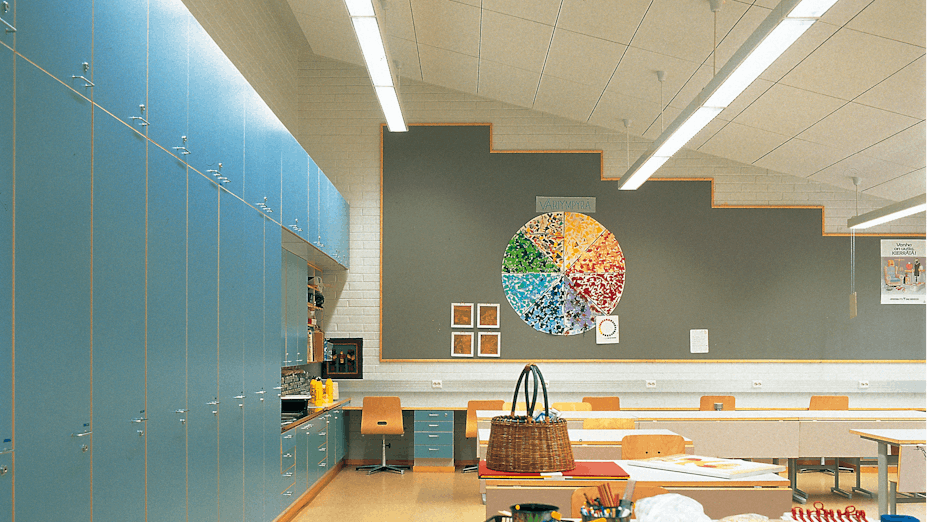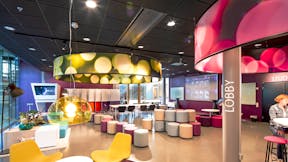
Cultural Sensitivity and Colour Use in Classrooms
Cultural sensitivity is another factor to consider when selecting colours to use in classrooms. Designers must take into consideration how culture influences colour response, making sure that all students feel recognised and respected..
For example, research indicates that red in Western societies often implies a sense of excitement or urgency. [5] In India, it's associated with purity, and in Latin American culture, it symbolises Christianity when used with white. In the Middle East, it's more commonly associated with caution or danger, while in China, it has more of a focus on luck and happiness.
Blue in the West typically offers a sense of trust and safety, while in Eastern cultures symbolises immortality and spirituality. [6] Latin American cultures associate this colour with mourning. [6]
When creating an engaging learning environment, consider the cultural diversity of the student population.
The Impact of Texture in Learning Environments
In addition to colours, texture also plays a vital role in an inclusive learning environment. Using plants, rugs, and textiles can add depth, feel, and sensory development to the learning environment, improving its visual appeal.
Too many objects within a space create cluttered, overwhelming feelings and numerous distractions due to the cognitive process in the brain. There simply is too much for the student to look at to focus on one key area.
Sensory integration therapy also incorporates texture, along with colour, smell, and sight, to help support brain development. For example, students with Autism Spectrum Disorders can be hypersensitive to touch, so using tactile elements can help to reduce their sensitivity over time.
How Texture Impacts Learning
Texture changes emotions and cognitive psychology based on student perception. However, perceptions towards texture are very personal. That is, some textures may bring back memories of an earlier experience. Other times, especially in children with special learning needs, texture may have a negative experience because it is new and unknown.
It is not just about what one texture can offer but the exploration of different textures within that space.
There is some insight into how various texture works in the learning environment [7]:
- Placing contrasting textures near each other stimulates interest.
- Metal tends to feel cold and isolating.
- Softness in rugs or other tactile elements is comfortable, welcoming, and warm.
- Shiny textures, like silk or gold, create an illusion of feeling brighter and clean.
- Wood, stone, and soft fuzzy elements are more focused on nature and create an inviting feel.
- Smooth surfaces tend to improve focus, such as a desktop offering a blank slate from which to learn.
Textures can be touchable. But they're also visually perceived through 2D and 3D patterns, with the latter giving the illusion of depth and textures.
- Raindrops
- Leaves
- Petals
- Scales
- Parched soil
- Geometric shapes
- Flowing curves
- Organic
- Chaotic
- Stone
- Reflections
- Wood grain
You can incorporate these into wall designs, furniture, classroom art, and children's projects alike.
Creating a Universal Design for Learning
When creating an inclusive learning environment, it's essential to take into account different factors, such as students' special education needs, cultural background, age, sensory processing abilities, and the type of learning that takes place in that space. By considering these elements, we can ensure that all students have an equitable opportunity to learn in a supportive and comfortable environment:
- Learning centres designed for quiet activities, such as reading, should offer comfortable surfaces including softer chairs and have a green colour pattern.
- Smooth desk surfaces help to encourage use and stimulate focus, making them an important functional tool for note-taking. To encourage classroom discussions in this space, incorporate the use of orange.
- Place red near the instructor to draw attention, but limit the amount of texture within this space that could be distracting. A whiteboard is a better option than a bulletin board for instructor-led learning because it’s simpler and not distracting.
A deep understanding of educational psychology and how colour and texture play a role in the process makes teaching students more effective and, in some cases, more enjoyable.
Sources
- Baper, Salahaddin, Husein Husein, and Sazgar Salim. 2021. Review of The Impact of Colour on Students’ Perception in Learning Spaces. Tikrit Journal of Engineering Sciences 28 (2): 33–43. https://www.researchgate.net/publication/352910114_The_Impact_Of_Colour_On_Students
%27_Perception_In_Learning_Spaces. - Jonauskaite, Domicele, Ahmad Abu-Akel, Nele Dael, Daniel Oberfeld, Ahmed M. Abdel-Khalek, Abdulrahman S. Al-Rasheed, Jean-Philippe Antonietti, et al. 2020. “Universal Patterns in Color-Emotion Associations Are Further Shaped by Linguistic and Geographic Proximity.” Psychological Science 31 (10): 1245–60. https://doi.org/10.1177/0956797620948810.
- Graham, Edward. n.d. “Maximizing Student Success with Least Restrictive Environments and Appropriate Models of Inclusion | NEA.” Www.nea.org. https://www.nea.org/advocating-for-change/new-from-nea/maximizing-student-success-least-restrictive-environments-and-appropriate-models-inclusion.
- O'connor, Sofo, Kendall, and Olson. 1993. “Spring/Summer 2011Boyatzis & Varghese.” Journal of Family & Consumer Sciences Education 29 (1). https://www.natefacs.org/Pages/v29no1/v29no1Gaines.pdf.
- “Culture, Language, and Color Perception | Alec Parker.” n.d. U.osu.edu. https://u.osu.edu/parker1211esltech/culture-language-and-color-perception/.
- Azeemi, Samina T. Yousuf, Hafiz M Rafiq, Iram Ismail, Syeda Rabab Kazmi, and Ameena Azeemi. 2019. “The Mechanistic Basis of Chromotherapy: Current Knowledge and Future Perspectives.” Complementary Therapies in Medicine 46 (October): 217–22. https://doi.org/10.1016/j.ctim.2019.08.025.
- “How Do Textures Change the Emotions in a Space?” 2022. RTF | Rethinking the Future. August 19, 2022. https://www.re-thinkingthefuture.com/architectural-community/a7577-how-do-textures-change-the-emotions-in-a-space/.




